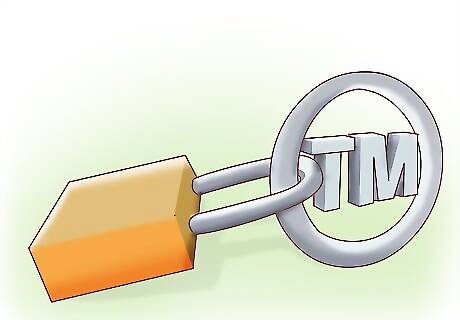
views
X
Trustworthy Source
United States Patent and Trademark Office
U.S. government agency responsible for registering and protecting patents and trademarks
Go to source
In order to obtain a trademark, you must come up with a unique mark that isn't already in use, then file an application and pay the filing fee. If your application is approved, you'll be free to use your trademark in commerce.
Conducting a Trademark Search

Determine whether your mark is strong. The first step in the trademark process is to make sure your name - or "mark" - fits the United States Patent and Trademark Office (USPTO) definition of strong. The mark must have a non-intuitive, secondary meaning that represents your services or product, and no one else's. The USPTO divides marks into four different categories different strength levels, and those that fall into the "weaker" categories have very little chance of getting trademarked. Here are the categories, from strongest to weakest: Fanciful and arbitrary. Fanciful or arbitrary marks are the strongest type, because there's a slim chance someone else would independently think them up and start using them. Made-up words and words that aren't usually associated with a certain product or service fall into this category. For example, naming a shoe company "Brunnox" would be fanciful, and naming a beer product "Flashlight" would be arbitrary. Suggestive. A suggestive mark is one that suggests, but doesn't overtly describe, a certain service or product. Marks in this category aren't quite as strong as those considered fanciful or arbitrary, but you can still get a suggestive mark trademarked if it meets other requirements. Using "Soft and bright" as the slogan for an undershirt company would be suggestive. Descriptive. This category of marks is considered weak; there's a good chance other people could independently use the same mark, which would make the trademark protection difficult to enforce. Calling a cleaning service "Wash and Scrub Cleaners" would be descriptive. Generic. It is not possible to trademark a word that falls into this category. Generic marks are in widespread, common use, and it would be impossible to enforce a trademark protection. Naming a lantern company "Lantern" is an example.

Generate search terms. Once you've come up with a strong mark, it's time to make sure it isn't already in use. If another company has already trademarked your company name, you will be unable to trademark the name yourself. Start by thinking up some search terms. Since your goal in performing this search is to determine whether another company is using the name that you want to trademark or anything very similar, you will want to choose search terms that match your company name exactly and those that are very similar to your company's name.

Perform a basic trademark search online. Begin the search by typing your search terms into an online search engine such as Google.com. Note the results of each of your search terms, taking special note of those results that are very similar or identical to your company name. Note the type of product or service that any similar marks are used to represent. Any mark that is very similar to your company name that also represents a similar product or service to your company should be noted. For example, if your company is engaged in the business of making and selling hair spray, look in the search results for the mark being used in connection with hair care products.

Perform a basic Trademark Electronic Search System (“TESS”) search. A TESS search uses the USPTO's record of registered trademarks (and applications ) to search for your company name. To do the search, go to the USPTO website, navigate to the TESS search page, and type in your search terms. Take note of the search results as you did in the previous step.

Consider hiring a trademark attorney. After conducting your search, you should have a good idea of whether another company has already trademarked your company name or something very close to it. You may also see applications of others that have already been denied for various reasons. If you find that another company has a mark similar or identical to yours but you still wish to proceed with using your company name, you should consult a trademark attorney in order to determine if you are legally entitled to do so. If you find no other company using your name as their own mark, you may still want to hire a trademark attorney to ensure that your search was accurate. An attorney will also help you complete the complicated filing process.
Filing a Trademark Application

Obtain a trademark application. Trademark applications can be submitted either by mail or electronically. To obtain a PDF version of the trademark application, visit the USPTO website. You can either fill out the application electronically or print it out and mail the completed form to the USPTO.

Fill out the trademark application. The USPTO website has detailed instructions to follow when filling out the Initial Application form. The form requires the name of the applicant, which in this case is the Company, your address, a rendering of the trademark (a piece of paper with the trademark on it, or in a digital file in an approved format), and the type of product or service the mark will be used for. A "specimen" of the trademark "in use" on goods or services must be attached or submitted prior to final issuance of the registration. Complete the entire form and attach all requested documents. Be careful! Naming yourself as the owner, instead of the company may void your application if the company is a separate legal entity, such as an LLC or corporation.

Pay the filing fee. Depending on the method of filing, the filing fee will either be either $275 or $325.

Submit the application. Submit the application either online by using the USPTO website or by mail. Be sure to attach any required documentation to the application and ensure that the application is completely filled out. The application review process takes several months to complete, and the USPTO will send you a notice of any action it has taken on your application. You should also monitor the TESS database, from time to time, to follow the progress on your application. You will be notified when your application is "allowed" and then "published for opposition".

Promptly respond to all USPTO correspondence. The USPTO will review your application and will contact you if you have made any errors in filling out the application or if your application is not approved. You should respond to any correspondence from the USPTO as promptly as possible. Do not be quick to give up if the application is initially rejected. The USPTO examiners sometimes make mistakes or may be seeking clarification from you. You may consider hiring a trademark attorney to help you respond to the USPTO.

Enforce your trademark. The USPTO does not enforce trademarks, other than preventing others from registering a brand confusingly similar to those already registered. If your trademark is approved, you'll be responsible for enforcing it by taking legal action if someone else begins using it. If you don't enforce your trademark, and it starts to get widely used "generically", you could lose your trademark protection. You will need to make additional USPTO filings to maintain your registration, starting 5 years after issuance, then renewal at 10 years. You should also have someone scan TESS and the Internet, from time to time, to spot possible infringements being filed or used before they get too far. Be sure to use the "circle-R" mark ® on your trademark, but only when used in association with the goods or services included in your registration. You may use TM or ™ when using your brand on other things not federally registered. Avoid using ® or ™ on the company name when used to identify the company rather than the particular goods or services under your brand.



















Comments
0 comment